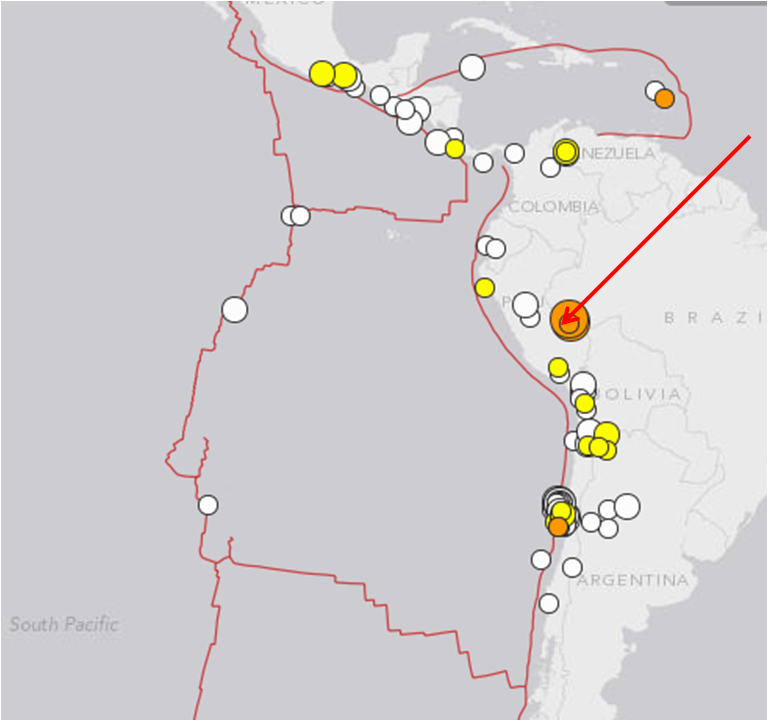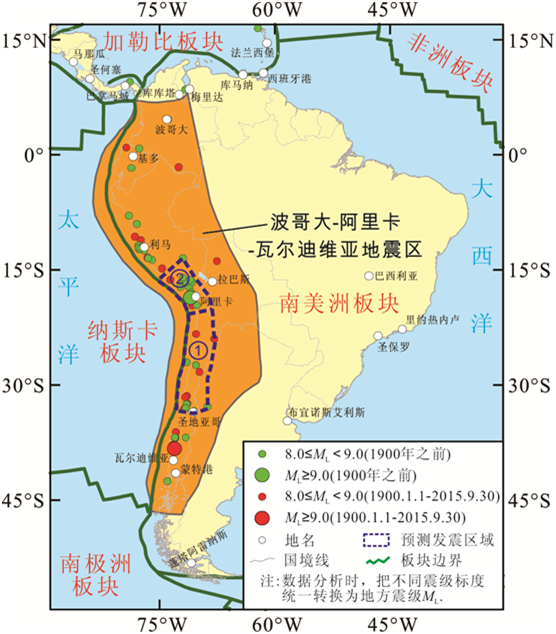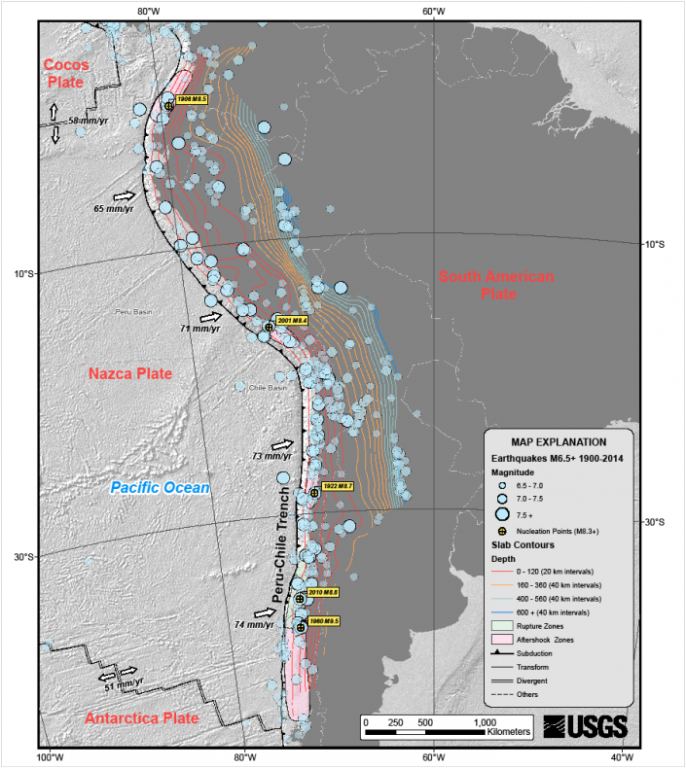博文
波哥大-阿里卡-瓦尔迪维亚地震区再遭深源大震袭击
||||
据NEIC测定,今天在秘鲁发生两次深源地震,参数如下:
1. 7.6 208km NW of Iberia, Peru 2015-11-2506:50:52 UTC+08:00 606.6 km
2. 7.6 169km WNW of Iberia, Peru 2015-11-2506:45:38 UTC+08:00 600.6 km

图1 近7天M $\geqslant$ 4.5级地震
Two powerful deep-focus earthquakes occurred in the Bogota-Arica-Valdivia seismic zone (Fig.2) struck Iberia, Peru on 25 November2015.

图2 波哥大-阿里卡-瓦尔迪维亚地震区地震构造图
看来俺的判断【2】基本正确——“预计在MW8.8~9.0级地震发生前,该区仍有可能发生MW8.0级左右的preshock或foreshock事件。”
该双震发生后,该区的实际CBS监测值为2.68×1010 J1/2,已相当接近临界值2.70×1010 J1/2(图3),该区的巨震已“瞎子磨刀”越磨越快啦。

图3 波哥大-阿里卡-瓦尔迪维亚地震区1982.9.6 - 2015.11.25之间CBS值与时间关系
(第2孕育周期)
(数据分析时选取ML≥5.0级地震事件)
从目前的地震活动性和地震空区判断,巨震发生在区①的可能性大。敦促智利、玻利维亚、秘鲁、巴西、阿根廷等国立即采取有效的防震减灾措施。
我们将持续跟踪该区地震活动性动态,期望对震中位置和发震时间有更准确的判断。
好长时间没写英文了,练练手,亲们看看有没有错误?
Because an oncoming earthquake with MW8.8~9.0 will take place in the Bogota-Arica-Valdivia seismic zone, we suggest the relevant countries in this zone should take effective measures for earthquake disasters reduction.
学术研究,科学探索。敬请不要复制、转载与外传该博文,违者必究!
震情跟踪博文:
[1]智利的巨震已“瞎子磨刀”啦
http://blog.sciencenet.cn/blog-575926-934038.html
[2]波哥大-阿里卡-瓦尔迪维亚地震区目前的态势
http://blog.sciencenet.cn/blog-575926-924506.html
[3]解读2015-09-16智利Mw8.3级地震
http://blog.sciencenet.cn/home.php?mod=space&uid=575926&do=blog&id=921331
[4]揭秘世界最大地震——1960年智利Mw9.6级地震
http://blog.sciencenet.cn/blog-575926-894935.html
Tectonic Summary
TheNovember 24, 2015 22:45 UTC M 7.6 earthquake was the first of two similarlysized events near the Peru-Brazil border in southeast Peru. Both earthquakesoccurred as the result of normal faulting at a depth of approximately 600 km,almost 1000 kilometers east of the Peru-Chile Trench within the subductedoceanic lithosphere of the Nazca plate. Focal mechanisms indicate ruptureoccurred on either a north or south-southeast striking, moderately dippingnormal fault. At the location of the earthquakes, the Nazca plate subducts tothe east under the South America plate at a velocity of about 69 mm/yr.
The 22:45UTC event preceded another M 7.6 earthquake (22:50 UTC) by 5 minutes; theevents were separated by approximately 50 km horizontally – slightly more thantypical location uncertainties of global earthquakes – and just 6 kmvertically. The two events also had approximately the same focal mechanism. Thelatter earthquake was almost certainly triggered by the earlier event.Seismologists sometimes refer to a pair of similarly sized earthquakes thatoccur at nearly the same time and location as an earthquake"doublet."
As itdescends eastwards from the Peru-Chile Trench off the west coast of Peru, theNazca plate is seismically active down to depths of about 200 km. Betweendepths of 200 km and 500 km, where the Nazca plate subducts beneath easternPeru, very few earthquakes are produced. Beneath Peru and Brazil in the borderregion near the November 24th earthquakes, the subducted Nazca plate is againseismically active between depths of about 500 km and 650 km. The deep part ofthe Nazca plate, in which the November 24th earthquakes occurred, took 10million years or more to descend from the point at which it initially thrustunder the South America plate.
Earthquakesthat have focal depths greater than 300 km are commonly termed"deep-focus" earthquakes. Deep-focus earthquakes cause less damage onthe ground surface above their foci than similar magnitude shallow-focusearthquakes, but large deep-focus earthquakes may be felt at great distancefrom their epicenters. The largest recorded deep-focus earthquake to date wasthe M 8.3 event that occurred at a depth of 600 km within the subducted Pacificplate beneath the Sea of Okhotsk offshore northeastern Russia in 2013. The M8.3 Okhotsk earthquake was felt all over Asia, as far away as Moscow, andacross the Pacific along the western seaboard of the United States. Prior to2013, the largest recorded deep-focus earthquake was a M 8.2 event thatoccurred at a depth of 630 km within the subducted Nazca plate near thenorthern Bolivian border in 1994, approximately 500 km southeast of theNovember 24, 2015 events. The Bolivia earthquake was also broadly felt acrossthe United States.
Over thepast century, 91 earthquakes with a magnitude of M 7 or more have occurred atdepths greater than 300 km globally; 13 of these were located in the sameregion as the November 24, 2015 events. The largest nearby event at thesedepths was the aforementioned M 8.2 Bolivia earthquake. The most recent largeevent in the immediate vicinity of the November 24, 2015 events was a M 7.0earthquake in October 1990, 15 km to the southeast.

Map of Tectonic Summary Region
http://earthquake.usgs.gov/earthquakes/eventpage/us100040ww#general_summary
https://m.sciencenet.cn/blog-575926-938396.html
上一篇:为何悟空对八戒的高升不喜反怒?
下一篇:为何尼加拉瓜——哥斯达黎加一带的地震们劲头足?
全部作者的精选博文
- • 日本西海岸7.5级地震意欲何为?
- • 开始第二次学术创业
- • 我的拟出版博文集《学海泛舟》之引言
- • 科研突破:下慢功夫
- • 深切缅怀王士天教授
- • 科研“避坑”指南